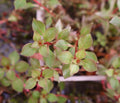Most Common Myths About Fishkeeping (Part 1)
There are many common misconceptions and myths floating around about fishkeeping and aquarium care. Some of these are even perpetuated by some pet stores that have not thoroughly looked into the information they are giving out about fish keeping. Here are some of the most common that I run into:
Most Common Myths About Fishkeeping (Part 1)
Fish can only grow as large as their aquarium.
This is possibly the most common myth I hear, and I know many stores still tout it as truth. However, it is untrue. To remain healthy and to live a normal and healthy life, fish need to be provided with sufficient space to grow and mature normally.
You need an air pump and air stones.
I'm not sure where this one comes from. The majority of fish tanks do not have any aeration from an air pump, but still many people ask if they have to get one, thinking that the fish will not have any oxygen in the water if there is no air pump.
You need to add salt to keep your fish healthy.
This one just strikes me as weird. Freshwater fish should be kept in fresh water, which is water without salt in it. Brackish water fish should be kept in brackish water, which is water with some salt in it. And marine or saltwater fish should be kept in water with enough salt in it to keep them healthy. Adding salt to a freshwater aquarium is unnecessary and possibly dangerous.
I believe this one comes from the fact that some diseases can be treated by temporarily raising the salinity of the water to kill off the pathogen (disease organism) causing the illness. However, this requires both a significant elevation in salinity and a change in salinity. Keeping the tank salty all the time will not help with disease resistance in freshwater fish, in fact, it will actually increase disease susceptibility by keeping the fish somewhat stressed all the time.
Stirring your gravel is dangerous.
OK, this one is partially true. If you never stir your gravel, then it will develop anaerobic pockets that will likely produce toxic gases. If this happens, then disturbing these anaerobic pockets can have disastrous results for your aquarium as the toxins are released into the tank at large. However, the development of these anaerobic pockets is actually an indication of poor aquarium care in the first place.
The gravel should be stirred regularly to ensure that these anaerobic pockets never develop, because if these dangerous anaerobic pockets do develop, they do not necessarily need to have the gravel stirred to release their toxins. For this reason, among others, vacuuming part of the gravel should be a part of your regular weekly 10-15% water change in every aquarium.
Fish require a pH of exactly 7.0 to live.
Very little water in nature has a pH of 7.0. Naturally occurring fresh water will have a pH that usually falls somewhere between 5.5 and 8.5, and the pH of the water will fluctuate even at a specific sampling location. Some fish do better in water that is more acidic (has a lower pH), while others do better in water that is more basic or alkaline (has a higher pH). However, almost all fish will thrive in water within an acceptable pH range.
Algae eaters and bottom feeders don't contribute to the tank population.
I think this is just a sales pitch. Any living thing added to the tank that will use oxygen and produce waste will contribute to the tank population.
Algae eaters and scavengers are necessary in an aquarium.
I think that this is also partially a sales pitch, but it seems that it is also partially a pipe dream as well. Many people, particularly new fish keepers, want to believe that there is some miracle that they can apply to their tank so that they do not have to take care of it any more. One aspect of this is to assume that the tank requires "scavenger fish" that will do the cleaning for you. However, this does not seem to have any basis in reality at all.
You can't overpopulate the tank.
This one is sort of related to a couple of the previous myths. Unfortunately, it is also untrue. The fish in your aquarium need to be supplied with sufficient oxygen to breathe, or they can suffocate in the tank. They also need to have their waste diluted and processed before they poison themselves with it. A fixed amount of water has a fixed capacity to handle these two requirements, and no matter what you do to it, you will still need to meet these needs for tank capacity.
Catfish will keep your tank clean.
Actually, most catfish are not scavengers; most are predators (though catfish with little, tiny mouths tend to go after little, tiny prey, and many catfish have deceptively large mouths). It is highly unlikely that a catfish will do anything to help clean your tank, and it would be unhealthy for them to eat the feces of other fish anyway. Fish waste should be removed with your regular weekly 10-15% water change, and excess food should be removed promptly so that it does not contribute to poor water quality.
Goldfish are messy fish.
Actually, unlike catfish, goldfish are scavengers. As far as a fish that will go around and clean up your tank for you, these fish are probably your best choice. Of course, this will not reduce the amount of care the tank requires, because the tank will still need all the same maintenance and care that the tank needs, including the regular weekly 10-15% water changes to keep the system clean and healthy.
In the next blog, we will continue to learn more of the Most Common Myths About Fishkeeping.
















